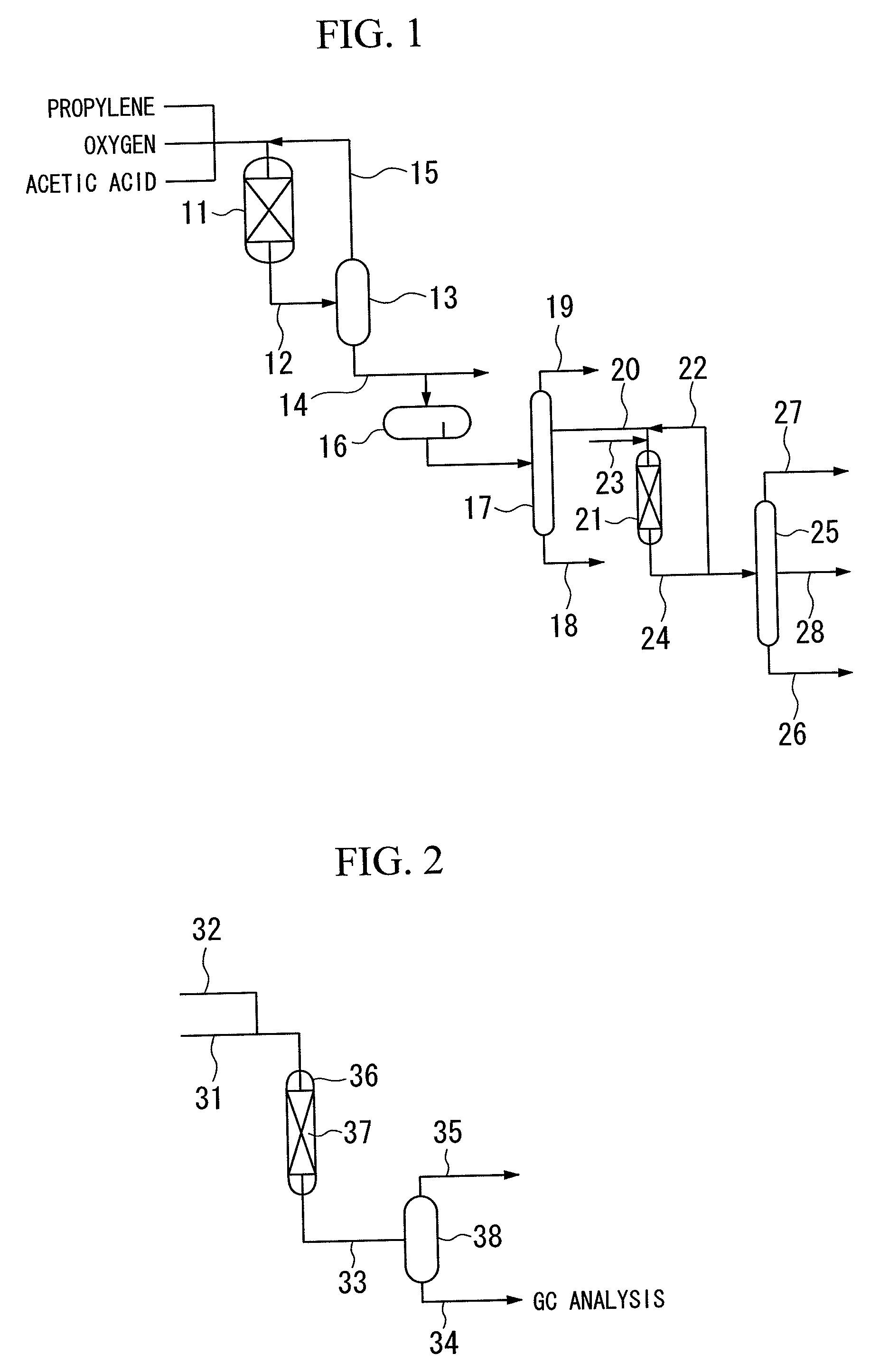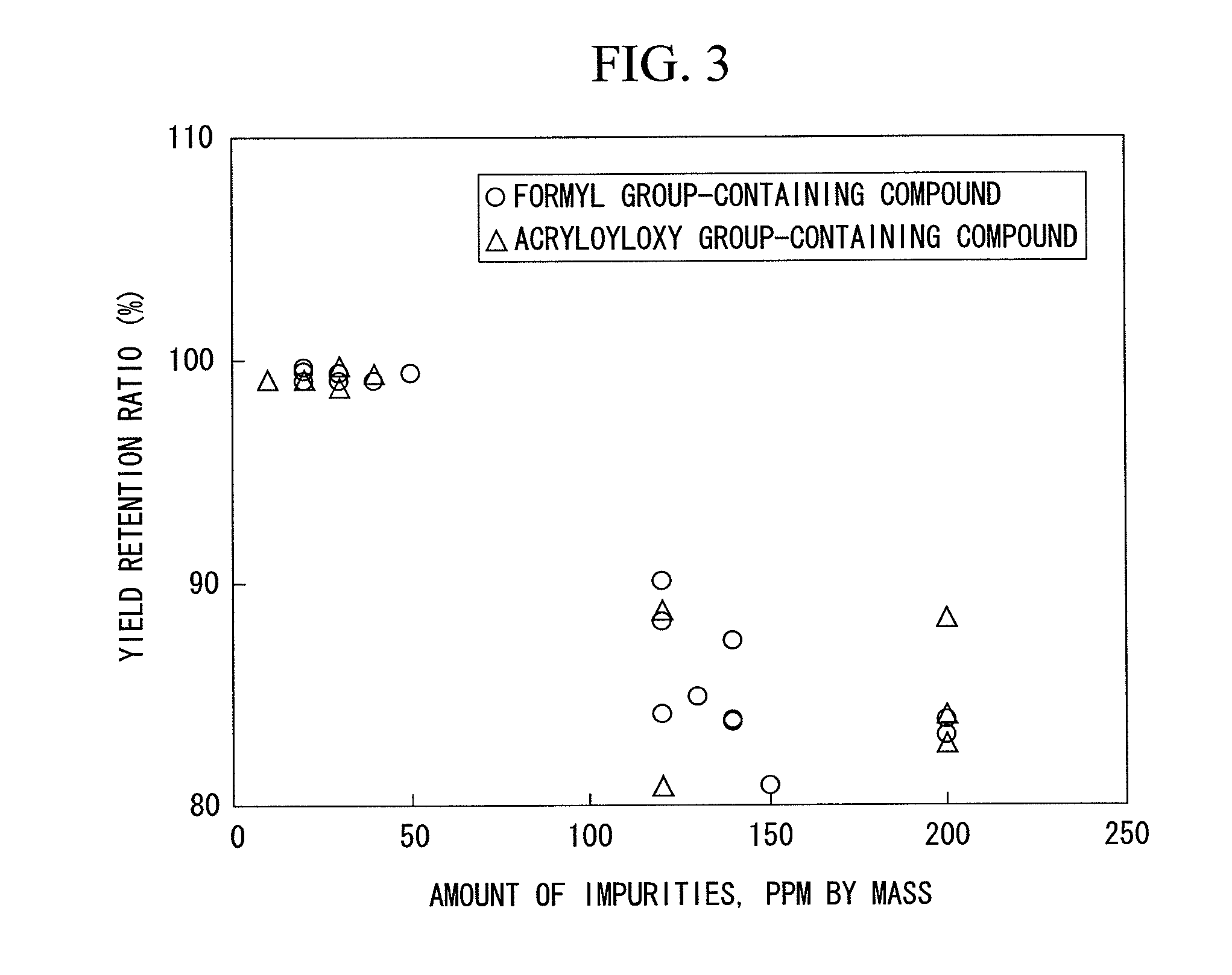METHOD FOR PRODUCING n-PROPYL ACETATE
a technology of n-propyl acetate and n-propyl acetate, which is applied in the preparation of carboxylic acid esters, chemical apparatus and processes, and organic chemistry, etc., can solve the problems of difficult to obtain a high raw material conversion rate and reaction rate, and the difficulty of consuming a large amount of energy during the separation of water by distillation, so as to reduce the frequency of catalyst exchange, reduce the production cost of n-propyl
- Summary
- Abstract
- Description
- Claims
- Application Information
AI Technical Summary
Benefits of technology
Problems solved by technology
Method used
Image
Examples
example 1
[0128]In the flow diagram shown in FIG. 2, 80 cc of a supported type palladium catalyst (alumina support, pellets having a diameter of 3 mm×a length of 3 mm, palladium content 0.3% by mass, “PGC Catalyst” manufactured by N.E. Chemcat Corp.) was packed as a hydrogenation catalyst in a stainless steel cylindrical reactor 36 (internal volume 80 cc) having an inner diameter of 20 mmφ to be used as a catalyst packed bed 37, and the pressure in the reactor 36 was adjusted to 0.8 MPaG with hydrogen gas. Hydrogen gas was passed through the reactor 36 from a hydrogen gas supply pipe 32 at a rate of 16.6 Nl / hr, and the electrical furnace set temperature in the reactor 36 was set at 80° C. Then, a mixed liquid of n-propyl acetate:allyl acetate=9:1 (vol %) as a reaction feed liquid (raw material liquid) was passed through the reactor 36 from the top of the reactor 36 through a liquid supply pipe 31 at a rate of 400 cc / hr (fixed bed type, gas-liquid downward co-current type).
[0129]The reaction f...
example 2
[0131]Allyl acetate was hydrogenated in the same manner as in Example 1, except that a supported type palladium catalyst (palm shell activated carbon carrier, pulverization product (4 to 8 meshes), palladium content 0.5% by mass, “0.5% Pd-Carbon Grain (W) LA type” manufactured by N.E. Chemcat Corp.) was used as the hydrogenation catalyst. The results are shown in Table 1 and FIG. 3.
example 3
[0132]Allyl acetate was hydrogenated in the same manner as in Example 1, except that a supported type platinum catalyst (alumina carrier, pellets having a diameter of 3 mm×a length of 3 mm, platinum content 0.3% by mass, “HDMax800Tab” manufactured by SÜD Chemie Catalysts, Inc.) was used as the hydrogenation catalyst. The results are shown in Table 1 and FIG. 3.
PUM
| Property | Measurement | Unit |
|---|---|---|
| concentration | aaaaa | aaaaa |
| reaction rate | aaaaa | aaaaa |
| latent heat of vaporization | aaaaa | aaaaa |
Abstract
Description
Claims
Application Information
 Login to View More
Login to View More - R&D
- Intellectual Property
- Life Sciences
- Materials
- Tech Scout
- Unparalleled Data Quality
- Higher Quality Content
- 60% Fewer Hallucinations
Browse by: Latest US Patents, China's latest patents, Technical Efficacy Thesaurus, Application Domain, Technology Topic, Popular Technical Reports.
© 2025 PatSnap. All rights reserved.Legal|Privacy policy|Modern Slavery Act Transparency Statement|Sitemap|About US| Contact US: help@patsnap.com


